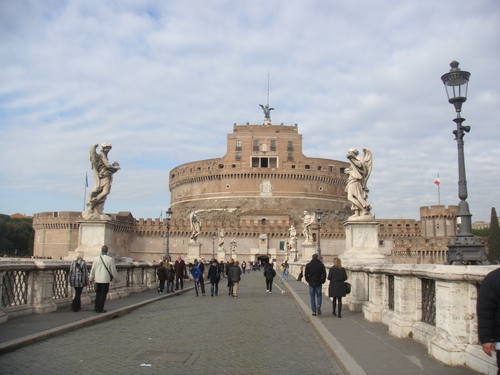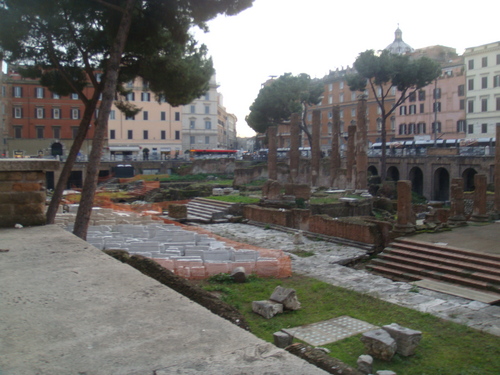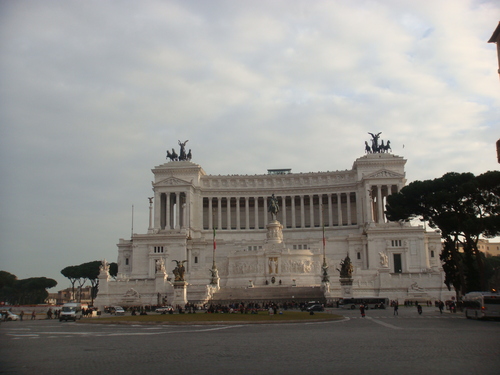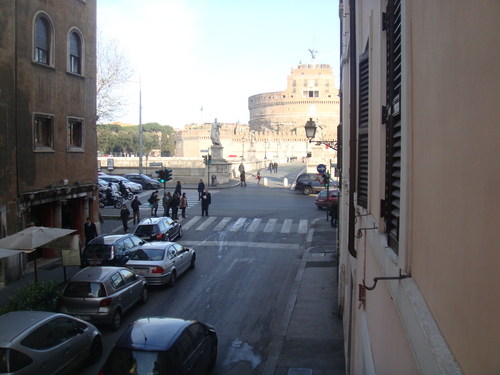Trying to immerse yourself in a language is really difficult. Well, at least I’m finding it so. I’ve always been pretty good at languages in general, or I guess Romantic languages; Japanese didn’t exactly come as easily to me when I dabbled in it last year. But I always got good grades in Spanish during middle school and high school, and for the most part, I’ve been able to breeze through Italian in college.
This was because of the way it was taught. This is a vocab list, memorize it. These are the grammar rules, write some practice sentences with them. It’s easy to get into the routine of that teaching style; just go with the flow and get the grades and that’s it.
I’m not studying Italian for any particular reason. I don’t have a drop of Italian blood in me, and it isn’t exactly a very widespread language. In fact, the Italian that I learned in college and the Italian that I’m learning now isn’t even a “natural” language. It didn’t develop naturally, like English did. It was created in order to unite Italy. Everyone in Italy speaks a regional dialect; a person from the north can barely understand someone from the south, because they’re like two completely different languages. But at least they have “standard Italian” to fall back on. If they know it.
But anyway. One of the big reasons I decided to start studying Italian was just because it’s pretty. It sounds nice to the ear. It’s flowy, and it reminds me of windchimes and roses. It sounds even better when it’s the language of an aria, because it’s really like a song.
Language–particularly written language–is my only way to describe my emotions. Inside my head and heart, I don’t actually define things with words, but rather with feelings. Everything and everyone has its own feeling, particularly if there’s also a distinct smell, sound, touch, taste, or sight associated with it. Periods of time in my life and locations also have incredibly specific feelings attached to them. I won’t remember someone with words, but with feelings; I see the image of their face in my mind’s eye, and the image immediately sends an electrical message of emotion right to about where my diaphragm is. If you ask me to describe someone, I’ll have to feel the feeling about them, dip my hand into the soup of feelings, and pull out whatever words I manage to find. I wish I could just touch my hand to yours and transmit the feeling instead, that way you’d know exactly how I mean.
It’s rare that I’m able to pick out the perfect combination of words to precisely convey those emotions, and it feels so satisfying when I do. Actually, the “windchimes and roses” bit is a good example of this moment. It’s vague enough that it’s fuzzy around the edges and blurry enough to be ethereal, yet it still gives you the right idea. Just like emotions. It’s like mist. Words need to be like mist, and they need to be visible–a tangible mist, something that you can feel floating through your fingers but can’t quite grab onto. That’s what it’s like.
This is why I’m so much better at writing than I am speaking. When I speak I find it very difficult to find exactly what I want to say, and I’ll stumble over my words, and you’ll often hear me say, “Oh…oh…you know what I mean!” because I just don’t know how to word the feeling. Yet, I still talk very quickly and I prefer writing in a stream-of-consciousness style (which is what this is) because everything comes to me so fast and it just kind of all spills out and I want you to know exactly what I’m feeling at this very instant! But writing does give me the time to think about it, plus some things I write would sound weird in colloquial speech. And typing is better because it’s faster than writing by hand, and usually I end up saying more because writer’s cramp sucks. Plus, I can proofread. But I usually don’t end up changing too much, unless I can finally think of those perfect combinations of words, the kind that makes you smack your lips and tongue in satisfaction. “Crisp” is a fantastic word for the feeling.
It is this fight between words not being enough and words being everything that is making this language immersion experience difficult for me.
It’s not that I go into class and am completely lost. Well, okay, admittedly sometimes. It’s mostly a lack of vocabulary if that happens, or if I drift off into space, which happens way more than it should. But after trying to listen intently for the first week of being here and exhausting myself because of it (just speaking Italian for awhile makes my mouth feel funny, because I’m exercising muscles I don’t normally use), I fell into a “lazy” mode during the second week, and instead of trying really hard to understand what was going on, I sat back and wanted it to come to me. I didn’t try. I had realized how listening to English was so easy for me–that it required no effort and that I could just listen and understand. I guess that’s where I want to be with Italian, and since I’m really impatient, I wanted it ASAP. But it was like pulling two elastics from opposite ends and trying to tie them in the middle, but the elastics were too short. I was trying to force a connection I wasn’t prepared to make.
I think it’s also a bit of a shock because I’m used to my Italian professors at home not only speaking at a good pace but also mostly using vocabulary that they expect us to know. But the professors here just talk, and they have regional accents. If they use a word that they don’t think we’ll know, they’ll define it–but in Italian. I’m so used to just getting the equivalent in English!
That’s the biggest problem, I think; if I really want to understand a word, I have to look it up or translate it into English. I rely on my Oxford English-Italian dictionary a lot, or if I do listen to the Italian definition, I’ll just come up with the English equivalent. I especially needed to do that for words like “siccome” and “a patto che”–“since” and “provided that.” “Andro’ al cinema a patto che Laura anche venga.” “I’ll go to the cinema provided that Laura also comes.” (And “a patto che” requires the following verb to be subjunctive and that’s a whole other ballgame that seems very much reliant on intuition.) But in order to truly understand “a patto che,” I needed the translation.
But why?
It’s because I inherently understand what it means. This is where the whole rambling feelings bit comes in. Not only have foreign languages come rather easily to me, but also my native English language. I’ve always prided myself on being good at grammar. I did well on the Writing SAT not because I studied hard or memorized rules or came up with any particular strategy, but because I could just look at a sentence and know if it FEELS right or not. I tried to tutor my younger brother on the Writing SAT once and I found it hard to explain why something was right or wrong (not to mention that I still don’t get 100% of the questions right). “It’s…just…’cause it is!”
Obviously the brain works in a way during the critical language period that makes you innately understand your native language(s). But when you’re an adult language learner, it’s different. A lot of people in the class want very technical explanations for grammar rules, and sometimes those are useful for me, too, but I understand it much better when I can just translate it into English, because then I can just attach an intuitive feeling to it and hopefully remember the next time it comes around. For example, prepositions can seem really arbitrary in Italian, and in many cases you just have to memorize which preposition is used with which verb. But of course, it’s been a lot easier for me to memorize the more “feely” ones. An example that comes to mind is “inammorarsi di” (“to be in love with,” but the preposition “di” usually means “of”). English speakers often will use “con” (“with”) instead of “di,” for obvious reasons. But it’s something I’ve been able to remember because it’s such an emotion-filled word.
But for me, “to be in love with” still has a stronger meaning that “inammorarsi di,” even though they mean exactly the same thing. Yet I think the latter sounds nicer. Additionally, it is more concise, though Italian isn’t always concise. “Laura’s dog.” “Il cane di Laura.” Yeah.
Though actually, now that I’m thinking about it, “love” and its Italian equivalent “amore” have different meanings for me. “Love” is not as nice-sounding, yet it seems more serious, deep, and cutting, like carving words into wood, permanent yet breakable. “Amore” is like a music staff on an ocean wave–it is more carefree, happy, blissful, yet fleeting. Hmm.
A better example of what I’m trying to describe is a couple weeks ago when we read a poem in my general Italian language class. I was able to read it, not knowing a few of the words, and get the general idea of what it was about. I could tell that it was a good poem, but I couldn’t quite grasp its beauty or genius, and I wasn’t on the same wavelength as the writer. For funsies, I decided to translate it into English (I have a translation class anyway, so why not?). When I had finished, I read the poem over again in English, and that’s when I was like, “Oh, oh…this is a REALLY nice poem.” What’s more was understanding that some of the Italian words I didn’t know had double meanings, which contributed to the poem. The poem itself was about a woman being obsessed/insane over a man who never truly loved her. There’s a part that says:
“Non devi rinnegare quell’alone (You don’t have to renounce that halo)
per te creato, che tu solo emani.” (That I create for you, that you alone radiate.)
The word “alone” (pronounced “ah-LOH-neh”) can also mean “ring,” which is what I initially translated it to until I saw the word “emani” in the next line, so then I changed it to “halo.” But I thought it was interesting that it could also mean “ring,” which implies marriage. That’s just something you don’t get when you don’t know the language! And regardless, I was frustrated that I could get into the author’s feelings until I translated it back into English. Here is such a nice-sounding language and I just want to dive into it head-first, but I’m too impatient and I can’t…
I guess what I’m trying to say is that learning a language in this way is making me appreciate my relationship with the English language. It makes me more proud of it, more connected to it, my safe place. I feel like no matter how much vocabulary I learn or how fluent I get, I’ll never have the same relationship with Italian as I do English. Despite the beauty of Italian, right now the words kind of feel like cardboard. I need to fill them with something (someone?), inject them with some kind of meaning in order to really entangle myself in it.
At the same point, however, I feel like a lot of students in my classes are too technical with it. It’s easy to see a language like a machine, I suppose; just learn the different parts and buttons and then make it work, let it whir. I suppose one could learn a language like this, but it just seems so…mechanical and detached. Like you’re just skimming the surface when there’s so much deeper.
So that’s why I need to find that balance. I still don’t know how to get it. I’m too attached to English, but even when I’m fully immersed in Italian, I can’t push it away. I guess it’s a part of me I’ll never be able to push away, but why would I even want to? I don’t need to.
I guess…maybe I’m seeing this wrong. Italian has always been a joy for me as well as a source of pride because I’ve been relatively successful with a passion that came from within me, that I incited on my own, not because I had to learn it in school. It’s still a balance, though; if I want to learn, I have to try, but I can’t try so hard. Just let it be a joy: not a mandatory job, yet not something that’s easy to put aside.
Maybe I’ll just keep thinking about windchimes and roses.
Location: Perugia, Italy











